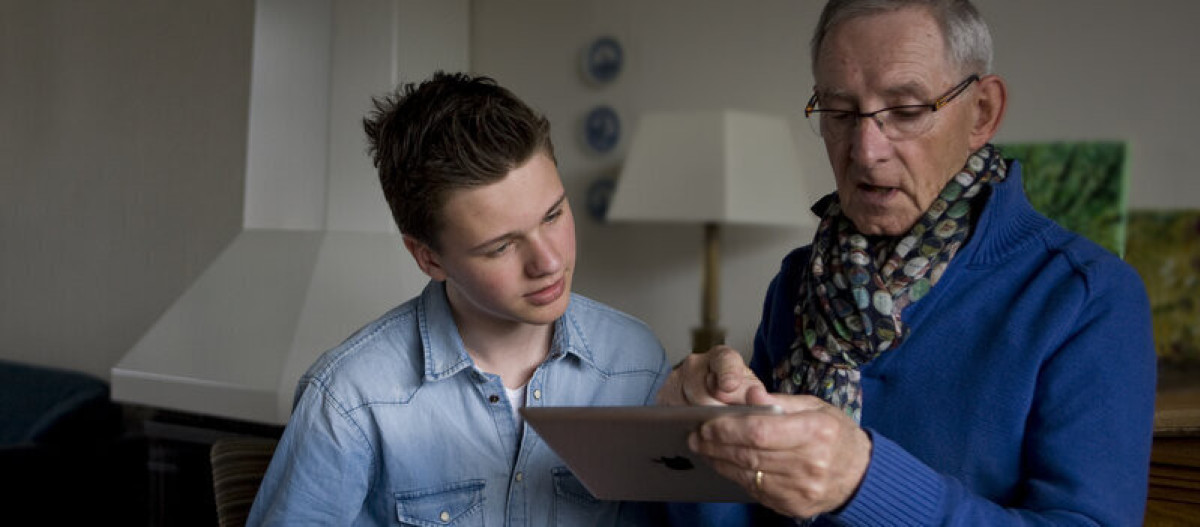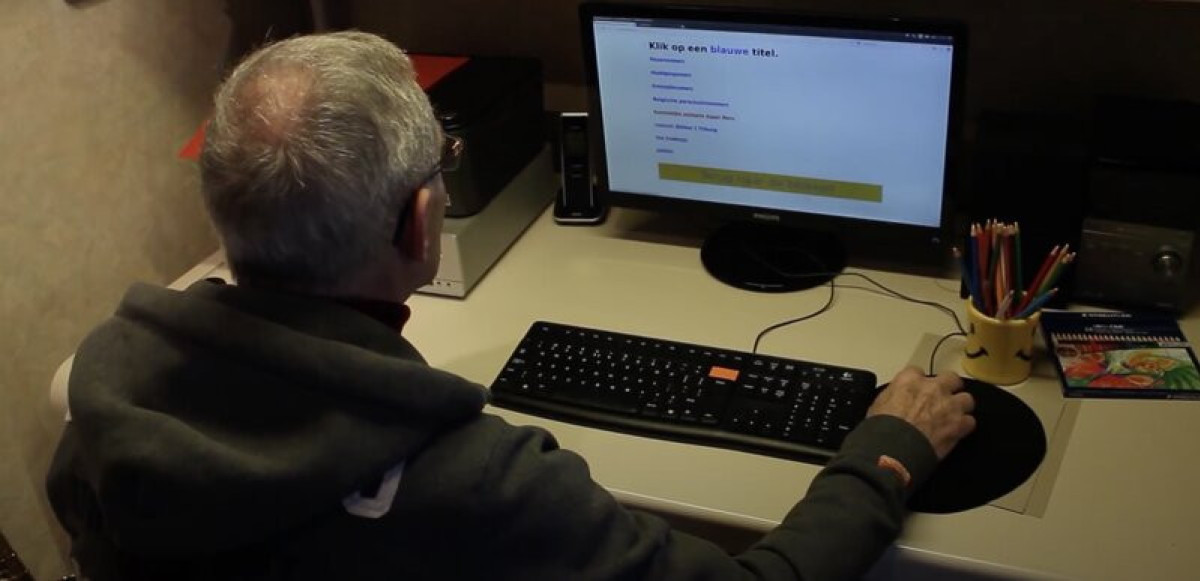Software for people with dementia
My grandad used to love working behind his computer. He designed postcards, kept an address book in Excel and looked up all kinds of stuff.
This all became more difficult as his dementia developed. Which is why I started thinking of solutions. I wrote easy-to-follow guides, organized his folders and programs in a clearer way and pasted instruction stickers on his keyboard. Solutions that worked for 3 months at best.

Because of this, I decided to learn to code and develop a simple app myself. This worked out well and my grandad enjoyed using it until his passing. I've learned a lot in these 4 years and still receive questions about it regularly. Which is why I find it meaningful to share my most insightful lessons with you.
1. The importance of color
My first priority was to reduce the infinite options computers offer. I sat next to my grandad and asked:
What 4 things do you want to keep doing on your computer?
The first homescreen design was finished 10 minutes later:

Translations: "YouTube", "Music", "Classic FM" (radio) and "Typing".
Grandpa started using it regularly. One day he tried to explain that he liked listening to the radio station "Classic FM". He couldn't find the words "radio" or "Classic FM". After thinking for 15 seconds he said:
I often listen to the green block.
Associating using colors was easy. Which makes sense. There are thousands of words and only a few main colors. He discovered words like "YouTube" later in life, whereas recognizing colors is one of the first things you learn as a child.
Later I discovered that colors can be used for more than just associations. I started researching colors and came across this article (Dutch) from Innovatiekring Dementie (Innovation Circle for Dementia). It states:
As we age, our eyes become yellower. This means we see colors with a longer wavelength (e.g., red) better than colors with a shorter wavelength (e.g., blue). Dementia intensifies this.
Previously I noticed that my grandfather opened "YouTube" (the red block) 70% of the time. I thought this was because he liked YouTube the most. As an experiment, I swapped "YouTube" and "Music". Suddenly, he opened "Music" 70% of the time.
By strategically arranging colors, I ensured that people unconsciously chose options they enjoyed best.
2. From Lego to Duplo
At first, my goal was to give grandpa the ability to do what he couldn't do before. And I am not the only one. The most common question other family-members of people with dementia asked me was:
My ... used to love doing ... on the computer. Can your app do that as well?
My grandfather used to enjoy working with Microsoft Word. Which is why I developed a simple text editor. He was able to use it. However, analytics showed he rarely did.
One day on the phone, my grandfather told me he had a new hobby: coloring pages. "Oh, cool!" I responded. Meanwhile, I thought confused, "Grandpa? Coloring?". In my head, coloring was something young children do.
The next time I visited, grandpa asked if I wanted to look at his coloring book. Everything I saw was colored outside the lines. And he was incredibly proud of what he had made.
This was the moment I realized that interests change as dementia progresses. I often compare this to Lego and Duplo. Toddlers can have a lot of fun playing with Duplo. After a while, they develop. Duplo stays in the cabinet more often and Lego appears. Where they used to find joy in Duplo, they now find joy in Lego.
People with dementia develop as well. In another way. This sounds sad but is something I experienced as something inspiring. They find joy in things that, from our perspective, are small and simple. My goal shifted from:
Enabling people to do what they could not before.
To:
Enabling people to enjoy using their computers.
3. Spending stimuli like money
Whenever something was unclear to grandpa, my first instinct was to add something. As my grandfather struggled with reading, I came up with the idea of audio instructions. I was a volunteer at a local radio station and bicycled (as a real Dutchman) to our studio to start recording. Think of instructions like: "Click here to return to the beginning" or "Click here to watch comedy."
As an inexperienced programmer, I puzzled for over 15 hours to make this work technically. I proudly demonstrated my newly added feature. Grandpa responded:
This is super annoying.
Doing product research with people with dementia is pretty straight forward. They are honest and their thought processes take long which makes them easy to follow.

As a developer/designer, I still apply principles I learned from my grandad. He taught me to spend stimuli like money. Audio instructions stimulate your brain a lot. The feature costs a lot of stimuli and has a low return on investment. The words could be read as well.
The difference between product development for people with and without dementia is that the stimuli budget for people with dementia is smaller.
4. Blind spots
I once asked my grandfather to click somewhere in the app. He pressed his mouse without releasing it and said:
It doesn't work.
When I saw his confused face, I tried to explain that a mouse only responds when you release the button. Something I had never thought of. He was not convinced.
But... the mouse made a click sound. Doesn't that mean I clicked?
To be fair, he had a point here. Later that day I changed the app to respond without releasing the mouse.
At this moment (2023, 7 years later), more developers decide to make their software react when pressing the mouse instead of releasing. Mainly to make the app feel faster.
Insights like this make it super awesome to develop for people with any disability. They make you think about stuff you would never think about yourself.
5. Attention
Nowadays, I think differently about what I did back then.
To test if the program was effective, I sat next to people with dementia and asked if they would help me. This gave them a sense of self-worth. We talked about the music they liked, which comedians they enjoyed watching, and selected family photos.
People enjoyed doing this. Which was proof to me that the app did it's job really well. In hindsight, I think the attention I gave during development was way more meaningful than the app itself. And watching YouTube together can also be done without special apps.
In conclusion
I have tried to turn this idea into a company for years but the business case never worked out. However, it did bring me a lot. It is the reason I started coding seriously. And the calmness and simplicity of the app are still present in my current designs.
Thanks for reading! Have any questions, feedback, or ideas to share? Feel free to send me an email at vic@vic-luijkx.nl 🙂.